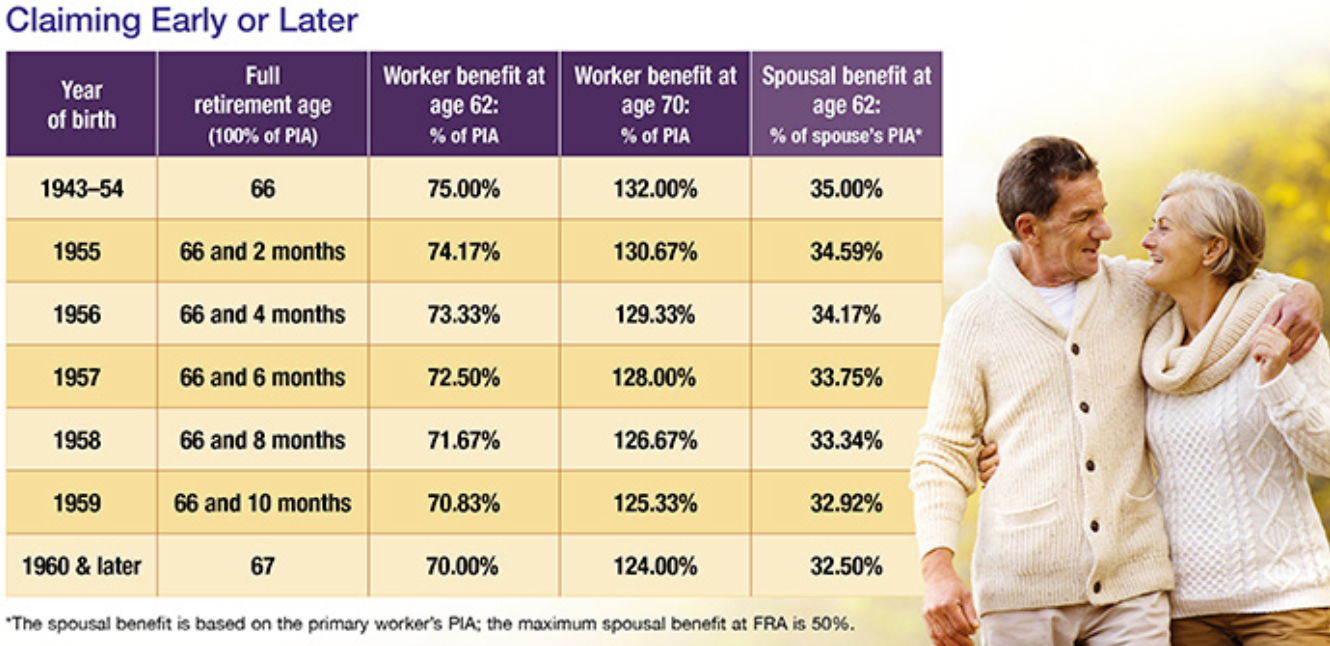The Basic of Social Security Benefits (Video)
Social Security Income
The Future of Social Security
Social Security 101
Social Security is complex, and the details are often misunderstood even by those who are already receiving benefits. If you’re looking forward to Social Security, whether in one year or 30 years, it’s important to understand some of the basic rules and options and how they might affect your financial future.
Full retirement age (FRA). Once you reach full retirement age, you can claim your full Social Security retirement benefit, also called your primary insurance amount or PIA. FRA ranges from 66 to 67, depending on your birth year (see chart).
Claiming early. The earliest you can claim your Social Security worker benefit is 62. However, your benefit will be permanently reduced if claimed before your FRA. At age 62, the reduction would be 25% to 30%, depending on your birth year. Your benefit may be further reduced temporarily if you work while receiving benefits before FRA and your income exceeds certain levels. (When you reach FRA, an adjustment is made and you will regain any benefits lost due to excess earnings.)

Claiming later. If you do not claim your benefit at FRA, you will earn delayed retirement credits for each month you wait to claim, up to age 70. This will increase your benefit by two-thirds of 1% for each month, or 8% for each year you delay. There is no increase after age 70.
Spousal benefits. If you’re married, you may be eligible to receive a spousal benefit based on your spouse’s work record, whether you worked or not. The maximum spousal benefit, if claimed at your full retirement age, is 50% of your spouse’s PIA (regardless of whether he or she claimed early) and doesn’t include any delayed retirement credits. It you claim a spousal benefit before reaching your FRA, it will be permanently reduced.
Dependent benefits. Your dependent child may be eligible for benefits after you begin receiving Social Security if he or she is unmarried and meets one of the following criteria: (a) under age 18, (b) age 18 to 19 and a full-time student in grade 12 or lower, (c) age 18 or older with a disability that started before age 22. The maximum family benefit is equal to about 150% to 180% of your PIA, depending on your situation.
Survivor benefits. If your spouse dies, you can claim a reduced survivor benefit as early as age 60 or a full survivor benefit — 100% of your deceased spouse’s PIA and any delayed retirement credits — if you wait until your full retirement age. If you are eligible for a survivor benefit and one based on your own work record, you could claim a survivor benefit first and switch to a benefit based on your work record at your FRA or later, if it would be higher.
Divorced spouses. If you were married for at least 10 years and are unmarried, you can receive a spousal or survivor benefit based on your ex’s work record. If your ex is eligible for but has not applied for Social Security benefits, you can still receive a spousal benefit if you have been divorced for at least two years.
These are just some of the fundamental facts to know about Social Security. For more information, including an estimate of your future benefits, see ssa.gov.
This information is not intended as tax, legal, investment, or retirement advice or recommendations, and it may not be relied on for the purpose of avoiding any federal tax penalties. You are encouraged to seek advice from an independent professional advisor. The content is derived from sources believed to be accurate. Neither the information presented nor any opinion expressed constitutes a solicitation for the purchase or sale of any security. This material was written and prepared by Broadridge Advisor Solutions. © 2018 Broadridge Investor Communication Solutions, Inc.
Will Social Security Retire Before You Do?

People have traditionally seen Social Security benefits as the foundation of their retirement planning programs. The Social Security contributions deducted from workers’ paychecks have, in effect, served as a government-enforced retirement savings plan.
However, the Social Security system is under increasing strain. Better health care and longer life spans have resulted in an increasing number of people drawing Social Security benefits. As the baby boom generation (those born between 1946 and 1964) has begun to retire, even greater demands are being placed on the system.
In 1950, there were 16.5 active workers to support each person receiving Social Security benefits. In 2016, there were only 2.8 workers supporting each Social Security beneficiary. And it is projected that there will be only 2.1 active workers to support each Social Security beneficiary by 2040.1
Although Social Security payments are typically adjusted for inflation, your own income and expenses may rise at a faster pace. And you might have to wait longer than you anticipated to qualify for full benefits.
It used to be that full benefits were available after you reached age 65. But since 2003, the age to qualify for full benefits has been increasing on a graduated scale based on year of birth. By 2027, the age to qualify for full Social Security benefits will have increased to age 67, where it is currently scheduled to remain.
That means you may have to wait longer to qualify for full Social Security benefits to start replacing a smaller percentage of your pre-retirement income.
When calculating the income you will have in retirement, you might recognize that Social Security benefits may play a more limited role. Some financial professionals suggest ignoring Social Security altogether when developing a retirement income plan.
Source: 1) Social Security Administration, 2016
Note: The Social Security Administration no longer mails an annual estimated benefit statement to all taxpayers. You can view your statement online by visiting www.ssa.gov/myaccount and creating your own personal Social Security account on the Social Security website.
The information in this newsletter is not intended as tax, legal, investment, or retirement advice or recommendations, and it may not be relied on for the purpose of avoiding any federal tax penalties. You are encouraged to seek advice from an independent professional advisor. The content is derived from sources believed to be accurate. Neither the information presented nor any opinion expressed constitutes a solicitation for the purchase or sale of any security. This material was written and prepared by Broadridge Advisor Solutions. © 2018 Broadridge Investor Communication Solutions, Inc.

